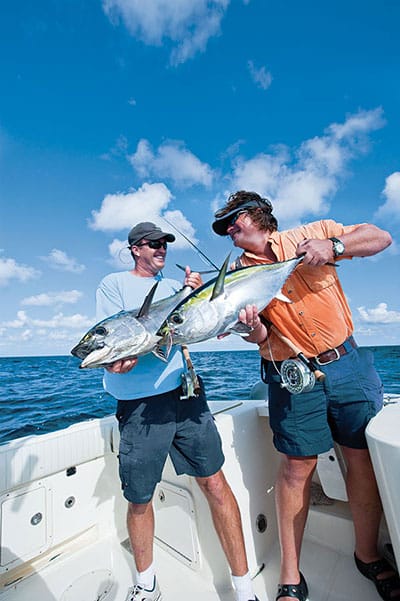
As we approached the underwater seamount known as the West Hump from the down-current side, we could see an occasional bust on the surface as tuna rose from the depths to pick off passing baitfish. The current ripped over the hump at about 31/2 knots, and the helpless baitfish were under attack from the tunas below and the marauding flocks of terns and gulls above.
Capt. Brian Cone steered the boat over the center of the hump as he watched the video sounder intently. The water grew increasingly shallow as we neared the top of the hump, and when we reached it, he simply said, “There they are.” A large red blotch on the sounder screen pinpointed what we had come in search of, a large school of blackfin tuna. Cone motored up-current past the fish before tossing out the first net full of live chum.
As the baitfish hit the water, the swift current carried them back to the waiting tunas. It was only a matter of seconds before the surface of the water erupted as the tuna attacked the terrified baits in much greater number than before, crashing in great boils behind the boat.
Carter Andrews and I pinned live pilchards to the 3/0 circle hooks attached to our spinning rods and flipped the baits back into the melee. We barely had time to close the bails on the reels before we were solidly fastened to a pair of blackfins, our first of the day. We managed to release those first two fish, and then we reset as Cone kept us positioned in front of the school, chumming all the while to keep them at the surface behind the boat.
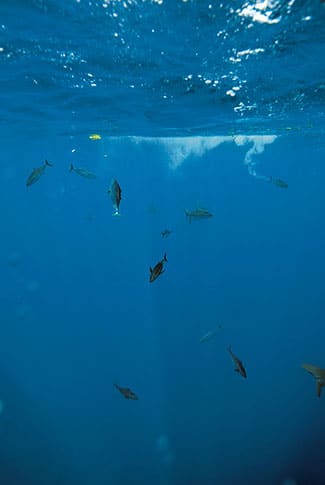
The Man in the Brown Suit
On our next pass, both of us hooked up as before, but neither of us landed the fish. A large pack of dusky sharks had appeared below us, with the occasional huge hammerhead thrown in, and they eagerly attacked any and all fish we hooked. We landed a couple but lost many more to the sharks before regrouping and deploying heavier tackle in the hope of muscling a tuna or two past the predators below.
We had been fishing 15- and 20-pound-test on light spinning rods but switched to stouter rods and heavier leader to thwart the sharks. By applying maximum drag and landing the fish as quickly as possible, we increased our success rate substantially.
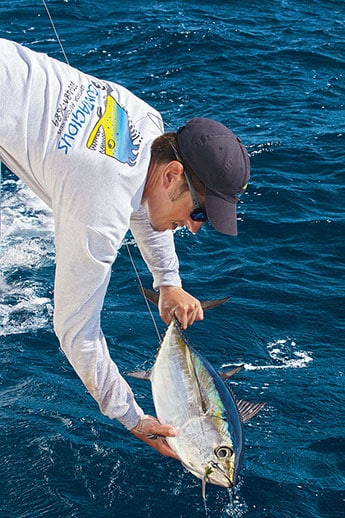
Live Bait Is Key
“The hardest part of being successful in this kind of fishing is getting the right bait, and enough of it,” Cone said as we moved back into position. “Then it’s simply a matter of knowing how to position the boat and how much bait to chum with to keep the tunas feeding actively.”
Early on the morning of our trip, we had gone in search of pilchard schools along the shoreline of the islands that make up Islamorada, in the heart of the Florida Keys. Cone grew up in Islamorada, so he knows every spot where bait might be found up and down the island chain. In short order he located a huge school of pilchards beneath diving pelicans, and after a few throws of the cast net, we were loaded and on our way offshore.
“Once you’ve gotten the bait, it’s important to know how to approach the fish,” Cone had explained on the way out. “Too many people just stop on top of the tuna school, put the boat in neutral and toss over a few baits. You might hook one that way, but the current will take you away from them so fast you’ll lose the school.”
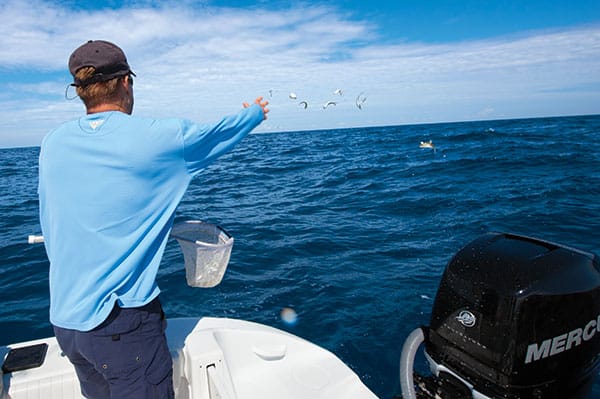
Power Drifting
Cone steered the boat into the current until he marked the fish, then continued up-current for about another 2,000 feet. With the current running at 31/2 knots, he kept the boat in gear and headed into the current at about 21/2 knots, effectively letting the boat drift slowly backward.
“It’s a little like back-trolling in fresh water,” he said. “You want to stay far ahead of the fish until you get them into the feeding mode.” To do that, Cone tosses a small number of baits overboard at first, maybe five at a time, at regular intervals. When the tunas spot the baits overhead in the current and crash on them, Cone dumps a large scoop of baits over to draw the fish to the boat.
An Epic Bite
On our second drift over the hump after pulling out the heavier tackle, Cone dumped baits over by the dozen after the tunas came up, and we soon had large blackfin and skipjack tunas swarming beneath the boat literally by the hundreds. The sharks stuck around too, but by altering our tactics and becoming more aggressive on the fish, applying maximum pressure the instant they bit, we lost very few to the sharks.
Andrews and I spent the better part of the next 21/2 hours hooked to fish. Cone kept the fish beneath the boat the whole time by keeping up a steady stream of live chum, even as the current took us far from the top of the hump. The sharks stayed behind, but the tuna remained with the boat as we moved slowly down-current, so we had a long stretch of uninterrupted action on fish up to 28 pounds.
Going Artificial
After catching several dozen tunas on bait, we switched things up and rigged with artificials. We tied on Sebile Bonga Minnows and tossed them to the waiting fish, with much the same results. The tunas crashed the lures with the same abandon as they had the pilchards. At one point Cone had the tunas so fired up that we hooked them by pulling the lures from the rod tips within a foot of the boat without casting at all.
Next we pulled out fly rods to see if we could land a few with those. We fished 20-pound tippet with 30-pound shock tippets, and the fish piled on the flies as well, although not quite as eagerly as they had the live bait. We fished Enrico Puglisi pilchard flies, which closely resemble the pilchards in both size and color, but we found that the tunas preferred flies with black backs over those with green backs, a counterintuitive reality. We had mostly green-backed flies, but a handy permanent marker remedied that situation in a hurry.
We moved back to the top of the hump before deploying the fly rods, and the sharks returned, so it took maximum heat on our part to keep from feeding the predators an easy meal. Fortunately, Andrews is an expert fly-fisherman and gave the sharks little to attack.
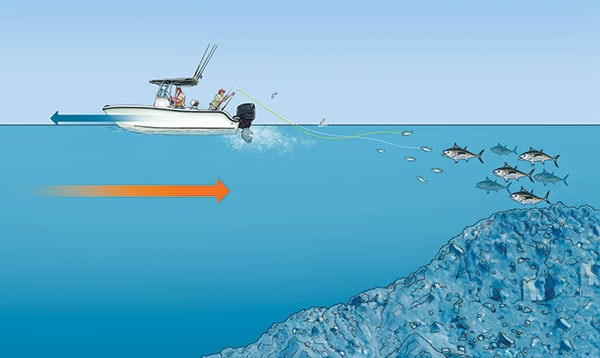
Simple Rigging
Cone uses simple rigs for the tunas. “Circle hooks provide a huge benefit because you can use a lot of drag with them and not pull the hook,” he said. He prefers the 3/0 Owner Mutu Light circle hook, and surprisingly, he does not usually use any
fluorocarbon leader: “Nylon mono is more limber, so the baits swim more naturally and you get more bites.
“Good healthy baits are extremely important,” he continued. “Use weaker-looking baits to chum with, and keep the best baits for your hooks. You can also hook them in different ways to be more effective. If you belly-hook them and keep tension on the line, they will swim down, and we sometimes bridle a bait so the hook doesn’t foul as much.” Cone will occasionally place a rubber-core sinker on the upper part of the leader to get baits down when the tunas are finicky.
Fortunately, we never encountered a finicky fish. Several hours of nonstop action wears you out, and with the bait supply finally exhausted and the tunas gone back to the depths above the hump, Andrews looked at me and could manage only one word. “Unbelievable!” he said with a broad grin.









